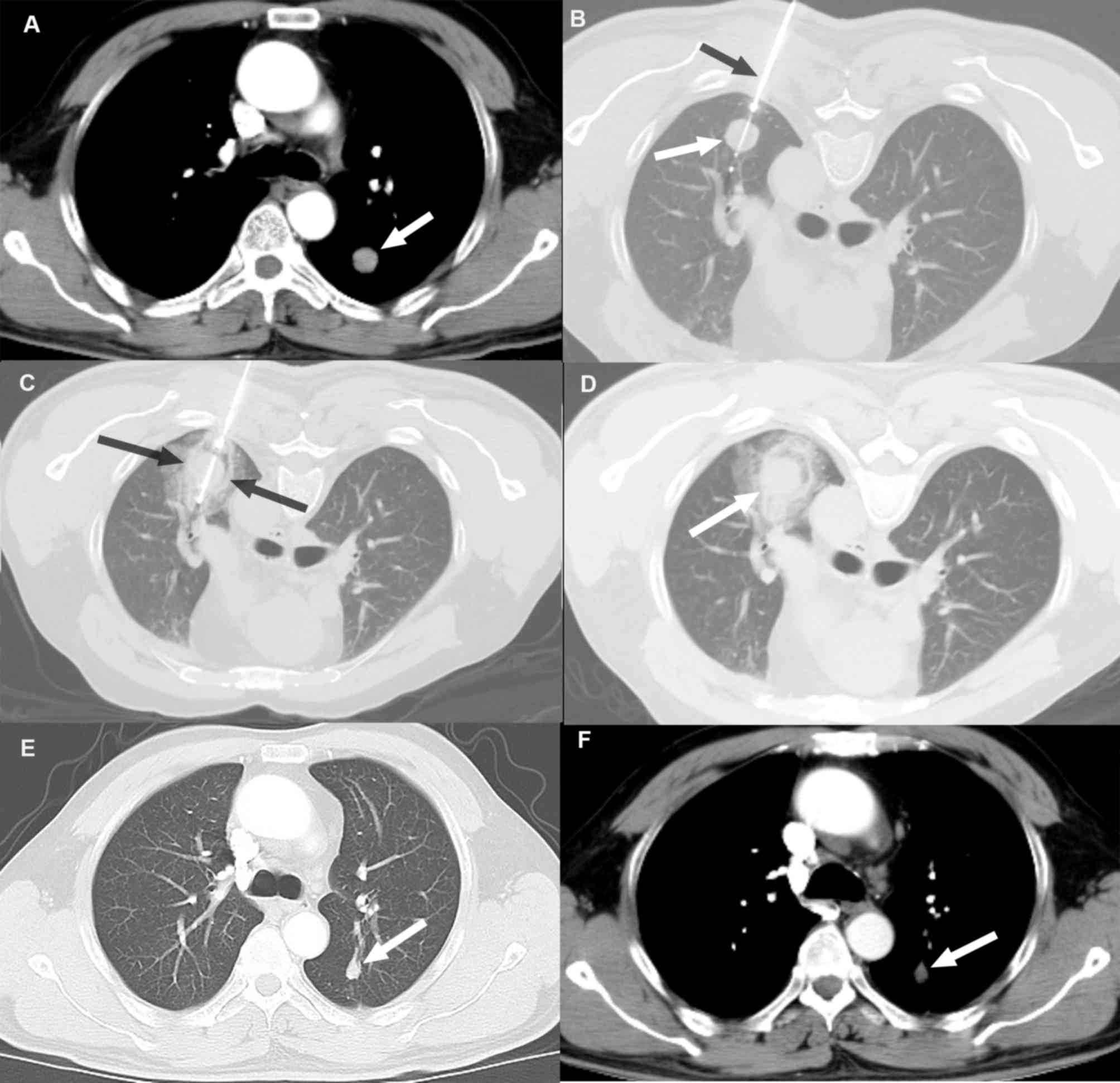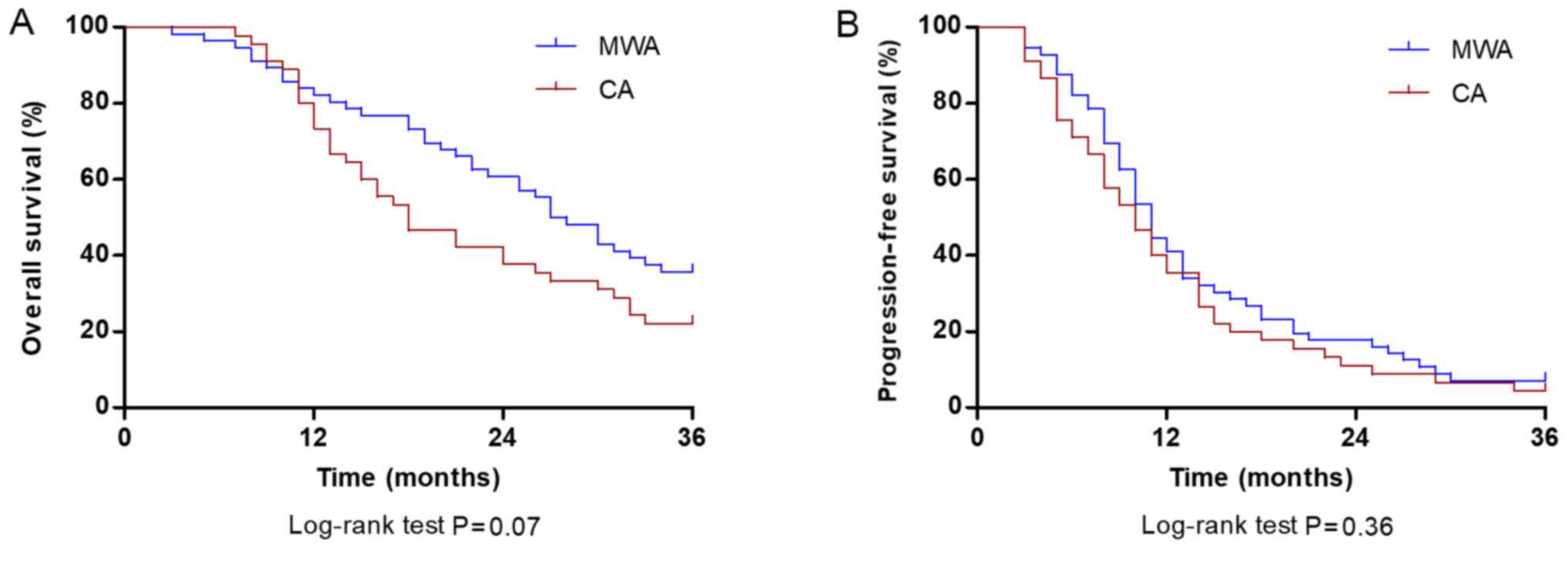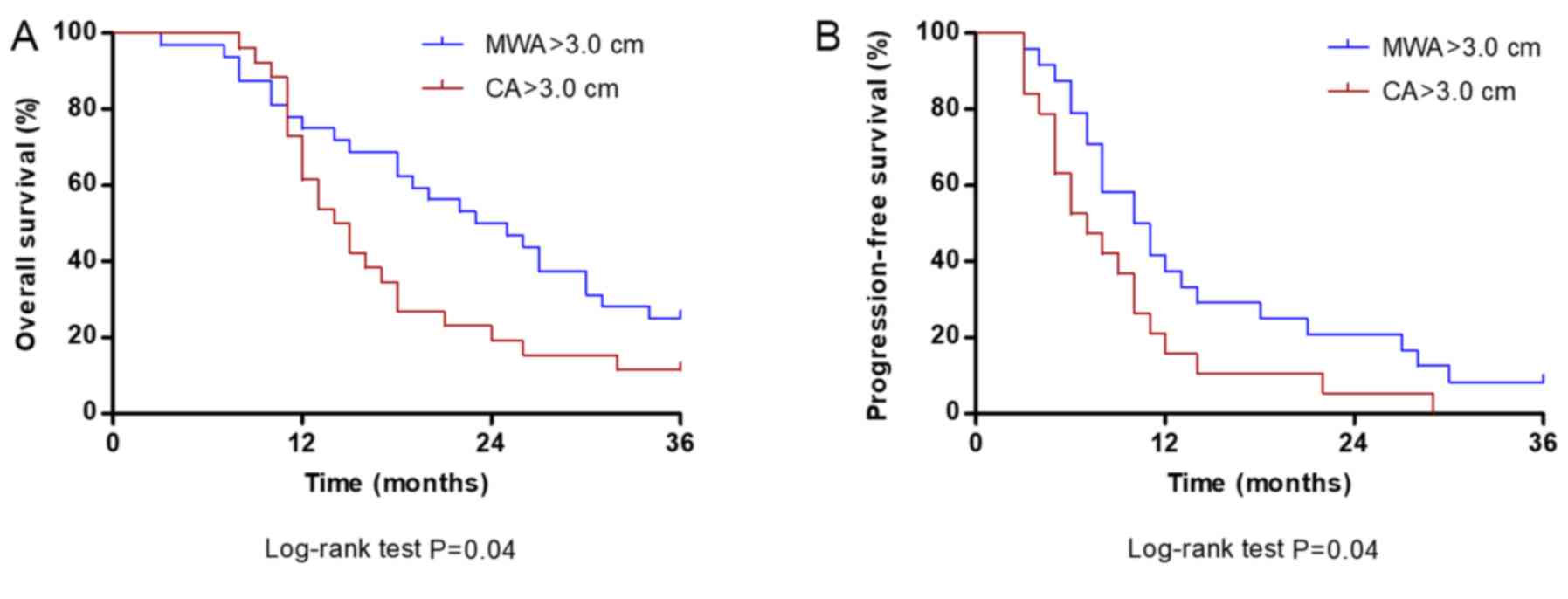|
1
|
Bray F, Ferlay J, Soerjomataram I, Siegel
RL, Torre LA and Jemal A: Global cancer statistics 2018: GLOBOCAN
estimates of incidence and mortality worldwide for 36 cancers in
185 countries. CA Cancer J Clin. 68:394–424. 2018. View Article : Google Scholar : PubMed/NCBI
|
|
2
|
Wei Z, Ye X, Yang X, Huang G, Li W, Wang J
and Han X: Microwave ablation plus chemotherapy improved
progression-free survival of advanced non-small cell lung cancer
compared to chemotherapy alone. Med Oncol. 32:4642015. View Article : Google Scholar : PubMed/NCBI
|
|
3
|
Cancer Facts & Figures 2019. American
Cancer Society's (ACS) publication; January. 2019, https://www.cancer.org/content/dam/cancer-org/research/cancer-facts-and-statistics/annual-cancer-facts-and-figures/2019/cancer-facts-and-figures-2019.pdf
|
|
4
|
Schiller JH, Harrington D, Belani CP,
Langer C, Sandler A, Krook J, Zhu J and Johnson DH; Eastern
Cooperative Oncology Group, : Comparison of four chemotherapy
regimens for advanced non-small-cell lung cancer. N Engl J Med.
346:92–98. 2002. View Article : Google Scholar : PubMed/NCBI
|
|
5
|
Scagliotti GV, Parikh P, von Pawel J,
Biesma B, Vansteenkiste J, Manegold C, Serwatowski P, Gatzemeier U,
Digumarti R, Zukin M, et al: Phase III study comparing cisplatin
plus gemcitabine with cisplatin plus pemetrexed in
chemotherapy-naive patients with advanced-stage non-small-cell lung
cancer. J Clin Oncol. 26:3543–3551. 2008. View Article : Google Scholar : PubMed/NCBI
|
|
6
|
Palussière J, Catena V and Buy X:
Percutaneous thermal ablation of lung tumors-Radiofrequency,
microwave and cryotherapy: Where are we going? Diagn Interv
Imaging. 98:619–625. 2017. View Article : Google Scholar : PubMed/NCBI
|
|
7
|
de Baere T, Tselikas L, Catena V, Buy X,
Deschamps F and Palussière J: Percutaneous thermal ablation of
primary lung cancer. Diagn Interv Imaging. 97:1019–1024. 2016.
View Article : Google Scholar : PubMed/NCBI
|
|
8
|
Baisi A, De Simone M, Raveglia F and
Cioffi U: Thermal ablation in the treatment of lung cancer: Present
and future. Eur J Cardiothorac Surg. 43:683–686. 2013. View Article : Google Scholar : PubMed/NCBI
|
|
9
|
Simon CJ, Dupuy DE and Mayo-Smith WW:
Microwave ablation: Principles and applications. Radiographics. 25
(Suppl 1):S69–S83. 2005. View Article : Google Scholar : PubMed/NCBI
|
|
10
|
Chi J, Ding M, Shi Y, Wang T, Cui D, Tang
X, Li P and Zhai B: Comparison study of computed tomography-guided
radiofrequency and microwave ablation for pulmonary tumors: A
retrospective, case-controlled observational study. Thorac Cancer.
9:1241–1248. 2018. View Article : Google Scholar : PubMed/NCBI
|
|
11
|
Ierardi AM, Floridi C, Fontana F, Chini C,
Giorlando F, Piacentino F, Brunese L, Pinotti G, Bacuzzi A and
Carrafiello G: Microwave ablation of liver metastases to overcome
the limitations of radiofrequency ablation. Radiol Med.
118:949–961. 2013. View Article : Google Scholar : PubMed/NCBI
|
|
12
|
van Tilborg AA, Scheffer HJ, de Jong MC,
Vroomen LG, Nielsen K, van Kuijk C, van den Tol PM and Meijerink
MR: MWA versus RFA for perivascular and peribiliary CRLM: A
retrospective patient- and lesion-based analysis of two historical
cohorts. Cardiovasc Intervent Radiol. 39:1438–1446. 2016.
View Article : Google Scholar : PubMed/NCBI
|
|
13
|
Niu L, Xu K and Mu F: Cryosurgery for lung
cancer. J Thorac Dis. 4:408–419. 2012.PubMed/NCBI
|
|
14
|
Sonntag PD, Hinshaw JL, Lubner MG, Brace
CL and Lee FT Jr: Thermal ablation of lung tumors. Surg Oncol Clin
N Am. 20369–387. (ix)2011. View Article : Google Scholar : PubMed/NCBI
|
|
15
|
de Baere T, Tselikas L, Gravel G and
Deschamps F: Lung ablation: Best practice/results/response
assessment/role alongside other ablative therapies. Clin Radiol.
72:657–664. 2017. View Article : Google Scholar : PubMed/NCBI
|
|
16
|
Yamauchi Y, Izumi Y, Hashimoto K, Yashiro
H, Inoue M, Nakatsuka S, Goto T, Anraku M, Ohtsuka T, Kohno M, et
al: Percutaneous cryoablation for the treatment of medically
inoperable stage I non-small cell lung cancer. PLoS One.
7:e332232012. View Article : Google Scholar : PubMed/NCBI
|
|
17
|
Moore W, Talati R, Bhattacharji P and
Bilfinger T: Five-year survival after cryoablation of stage I
non-small cell lung cancer in medically inoperable patients. J Vasc
Interv Radiol. 26:312–319. 2015. View Article : Google Scholar : PubMed/NCBI
|
|
18
|
Goto T, Izumi Y, Nakatsuka S and Nomori H:
Percutaneous cryoablation as a salvage therapy for local recurrence
of lung cancer. Ann Thorac Surg. 94:e31–e33. 2012. View Article : Google Scholar : PubMed/NCBI
|
|
19
|
Kawamura M, Izumi Y, Tsukada N, Asakura K,
Sugiura H, Yashiro H, Nakano K, Nakatsuka S, Kuribayashi S and
Kobayashi K: Percutaneous cryoablation of small pulmonary malignant
tumors under computed tomographic guidance with local anesthesia
for nonsurgical candidates. J Thorac Cardiovasc Surg.
131:1007–1013. 2006. View Article : Google Scholar : PubMed/NCBI
|
|
20
|
de Baere T, Tselikas L, Woodrum D, Abtin
F, Littrup P, Deschamps F, Suh R, Aoun HD and Callstrom M:
Evaluating cryoablation of metastatic lung tumors in
patients-safety and efficacy: The ECLIPSE trial-interim analysis at
1 year. J Thorac Oncol. 10:1468–1474. 2015. View Article : Google Scholar : PubMed/NCBI
|
|
21
|
Welch BT, Brinjikji W, Schmit GD,
Callstrom MR, Kurup AN, Cloft HJ, Woodrum DA, Nichols FC and Atwell
TD: A national analysis of the complications, cost, and mortality
of percutaneous lung ablation. J Vasc Interv Radiol. 26:787–791.
2015. View Article : Google Scholar : PubMed/NCBI
|
|
22
|
World Medical Association: World Medical
Association Declaration of Helsinki: Ethical principles for medical
research involving human subjects. JAMA. 310:2191–2194. 2013.
View Article : Google Scholar : PubMed/NCBI
|
|
23
|
Detterbeck FC, Boffa DJ, Kim AW and Tanoue
LT: The eighth edition lung cancer stage classification. Chest.
151:193–203. 2017. View Article : Google Scholar : PubMed/NCBI
|
|
24
|
Oken MM, Creech RH, Tormey DC, Horton J,
Davis TE, McFadden ET and Carbone PP: Toxicity and response
criteria of the Eastern Cooperative Oncology Group. Am J Clin
Oncol. 5:649–655. 1982. View Article : Google Scholar : PubMed/NCBI
|
|
25
|
Yang X, Ye X, Zheng A, Huang G, Ni X, Wang
j, Han X, Li W and Wei Z: Percutaneous microwave ablation of stage
I medically inoperable non-small cell lung cancer: Clinical
evaluation of 47 cases. J Surg Oncol. 110:758–763. 2014. View Article : Google Scholar : PubMed/NCBI
|
|
26
|
Common terminology criteria for adverse
events (version 4.0). https://evs.nci.nih.gov/ftp1/CTCAE/CTCAE_4.03/Archive/CTCAE_4.0_2009-05-29_QuickReference_8.5×11.pdfAugust
19–2018
|
|
27
|
Wewes ME and Lowe NK: A critical review of
visual analogue scales in the measurement of clinical phenomena.
Res Nurs Health. 13:227–236. 1990. View Article : Google Scholar : PubMed/NCBI
|
|
28
|
Pusceddu C, Melis L, Sotgia B, Guerzoni D,
Porcu A and Fancellu A: Usefulness of percutaneous microwave
ablation for large non-small cell lung cancer: A preliminary
report. Oncol Lett. 18:659–666. 2019.PubMed/NCBI
|
|
29
|
Wolf FJ, Grand DJ, Machan JT, Dipetrillo
TA, Mayo-Smith WW and Dupuy DE: Microwave ablation of lung
malignancies: Effectiveness, CT findings, and safety in 50
patients. Radiology. 247:871–879. 2008. View Article : Google Scholar : PubMed/NCBI
|
|
30
|
Li C, Wang J, Shao JB, Zhu LM, Sun ZG and
Zhang N: Microwave ablation combined with chemotherapy improved
progression free survival of IV stage lung adenocarcinoma patients
compared with chemotherapy alone. Thorac Cancer. 10:1628–1635.
2019. View Article : Google Scholar : PubMed/NCBI
|
|
31
|
Zhang X, Tian J, Zhao L, Wu B, Kacher DS,
Ma X, Liu S, Ren C and Xiao YY: CT-guided conformal cryoablation
for peripheral NSCLC: Initial experience. Eur J Radiol.
8:3354–3362. 2012. View Article : Google Scholar
|
|
32
|
Mahnken AH, König AM and Figiel JH:
Current technique and application of percutaneous cryotherapy.
Rofo. 190:836–846. 2018.(In English, German). View Article : Google Scholar : PubMed/NCBI
|
|
33
|
Hinshaw JL, Lubner MG, Ziemlewicz TJ, Lee
FT Jr and Brace CL: Percutaneous tumor ablation tools: Microwave,
radiofrequency, or cryoablation-what should you use and why?
Radiographics. 34:1344–1362. 2014. View Article : Google Scholar : PubMed/NCBI
|
|
34
|
Niu L, Chen J, Yao F, Zhou L, Zhang C, Wen
W, Bi X, Hu Y, Piao X, Jiang F, et al: Percutaneous cryoablation
for stage IV lung cancer: A retrospective analysis. Cryobiology.
67:151–155. 2013. View Article : Google Scholar : PubMed/NCBI
|
|
35
|
Niu L, Xu K, He W, GuoZ Q, Zhang SP, He TS
and Zuo JS: Percutaneous Cryoablation for patients with advanced
non-small cell lung cancer. Technol Cancer Res T. 6:451–452.
2007.
|
|
36
|
Li Y, Feng H and Nie Z: The long-term
effects and risk factors analysis in 253 cases advanced non-small
cell lung cancer treated with percutaneous cryosurgery. Chin Clin
Oncol. 15:346–349. 2010.
|
|
37
|
Wei Z, Ye X, Yang X, Zheng A, Huang G, Li
W, Ni X, Wang J and Han X: Microwave ablation in combination with
chemotherapy for the treatment of advanced non-small cell lung
cancer. Cardiovasc Intervent Radiol. 38:135–142. 2015. View Article : Google Scholar : PubMed/NCBI
|
|
38
|
Li X, Zhao M, Wang J, Fan W, Li W, Pan T
and Wu P: Percutaneous CT-guided radiofrequency ablation as
supplemental therapy after systemic chemotherapy for selected
advanced non-small cell lung cancer. AJR Am J Roentgenol.
201:1362–1367. 2013. View Article : Google Scholar : PubMed/NCBI
|
|
39
|
McDevitt JL, Mouli SK, Nemcek AA,
Lewandowski RJ, Salem R and Sato KT: Percutaneous cryoablation for
the treatment of primary and metastatic lung tumors: Identification
of risk factors for recurrence and major complications. J Vasc
Interv Radiol. 27:1371–1379. 2016. View Article : Google Scholar : PubMed/NCBI
|
|
40
|
Yashiro H, Nakatsuka S, Inoue M, Kawamura
M, Tsukada N, Asakura K, Yamauchi Y, Hashimoto K and Kuribayashi S:
Factors affecting local progression after percutaneous cryoablation
of lung tumors. J Vasc Interv Radiol. 24:813–821. 2013. View Article : Google Scholar : PubMed/NCBI
|
|
41
|
Zemlyak A, Moore WH and Bilfinger TV:
Comparison of survival after sublobar resections and ablative
therapies for stage I non-small cell lung cancer. J Am Coll Surg.
211:68–72. 2010. View Article : Google Scholar : PubMed/NCBI
|
|
42
|
Pusceddu C, Sotgia B, Fele RM and Melis L:
CT-guided thin needles percutaneous cryoablation (PCA) in patients
with primary and secondary lung tumors: A preliminary experience.
Eur J Radiol. 82:e246–e253. 2013. View Article : Google Scholar : PubMed/NCBI
|
|
43
|
Inoue M, Nakatsuka S, Yashiro H, Ito N,
Izumi Y, Yamauchi Y, Hashimoto K, Asakura K, Tsukada N, Kawamura M,
et al: Percutaneous cryoablation of lung tumors: Feasibility and
safety. J Vasc Interv Radiol. 23:295–302. 2012. View Article : Google Scholar : PubMed/NCBI
|
|
44
|
Wang H, Littrup PJ, Duan Y, Zhang Y, Feng
H and Nie Z: Thoracic masses treated with percutaneous cryotherapy:
Initial experience with more than 200 procedures. Radiology.
235:289–298. 2005. View Article : Google Scholar : PubMed/NCBI
|
|
45
|
Chou HP, Chen CK, Shen SH, Sheu MH, Wu MH,
Wu YC and Chang CY: Percutaneous cryoablation for inoperable
malignant lung tumors: Midterm results. Cryobiology. 70:60–65.
2015. View Article : Google Scholar : PubMed/NCBI
|
|
46
|
Yang X, Ye X, Zhang L, Geng D, Du Z, Yu G,
Ren H, Wang J, Huang G, Wei Z, et al: Microwave ablation for lung
cancer patients with a single lung: Clinical evaluation of 11
cases. Thorac Cancer. 9:548–554. 2018. View Article : Google Scholar : PubMed/NCBI
|
|
47
|
Steinke K, King J, Glenn D and Morris DL:
Pulmonary hemorrhage during percutaneous radiofrequency ablation: A
more frequent complication than assumed? Interact Cardiovasc Thorac
Surg. 2:462–465. 2003. View Article : Google Scholar : PubMed/NCBI
|
|
48
|
Nour-Eldin NE, Naguib NN, Mack M,
Abskharon JE and Vogl TJ: Pulmonary hemorrhage complicating
radiofrequency ablation, from mild hemoptysis to life-threatening
pattern. Eur Radiol. 21:197–204. 2011. View Article : Google Scholar : PubMed/NCBI
|
|
49
|
Hiraki T, Tajiri N, Mimura H, Yasui K,
Gobara H, Mukai T, Hase S, Fujiwara H, Iguchi T, Sano Y, et al:
Pneumothorax, pleural effusion, and chest tube placement after
radiofrequency ablation of lung tumors: Incidence and risk factors.
Radiology. 241:275–283. 2006. View Article : Google Scholar : PubMed/NCBI
|
|
50
|
Welch BT, Brinjikji W, Schmit GD,
Callstrom MR, Kurup AN, Cloft HJ, Woodrum DA, Nichols FC and Atwell
TD: A national analysis of the complications, cost, and mortality
of percutaneous lung ablation. J Vasc Interv Radiol. 26:787–791.
2015. View Article : Google Scholar : PubMed/NCBI
|
|
51
|
Zheng A, Wang X, Yang X, Wang W, Huang G,
Gai Y and Ye X: Major complications after lung microwave ablation:
A single-center experience on 204 sessions. Ann Thorac Surg.
98:243–248. 2014. View Article : Google Scholar : PubMed/NCBI
|
|
52
|
Lyons GR, Askin G and Pua BB: Clinical
outcomes after pulmonary cryoablation with the use of a triple
freeze protocol. J Vasc Interv Radiol. 29:714–721. 2018. View Article : Google Scholar : PubMed/NCBI
|
|
53
|
Ye X, Fan W, Wang H, Wang J, Wang Z, Gu S,
Feng W, Zhuang Y, Liu B, Li X, et al: Expert consensus workshop
report: Guidelines for thermal ablation of primary and metastatic
lung tumors (2018 edition). J Cancer Res Ther. 14:730–744. 2018.
View Article : Google Scholar : PubMed/NCBI
|
|
54
|
Hiraki T, Gobara H, Fujiwara H, Ishii H,
Tomita K, Uka M, Makimoto S and Kanazawa S: Lung cancer ablation:
Complications. Semin Intervent Radiol. 30:169–175. 2013. View Article : Google Scholar : PubMed/NCBI
|
|
55
|
Colak E, Tatlı S, ShynP B, Tuncalı K and
Silverman SG: CT-guided percutaneous cryoablation of central lung
tumors. Diagn Interv Radiol. 20:316–322. 2014. View Article : Google Scholar : PubMed/NCBI
|
|
56
|
Allaf ME, Varkarakis IM, Bhayani SB,
Inagaki T, Kavoussi LR and Solomon SB: Pain control requirements
for percutaneous ablation of renal tumors: Cryoablation versus
radiofrequency ablation-initial observations. Radiology.
237:366–370. 2005. View Article : Google Scholar : PubMed/NCBI
|
|
57
|
Li CL: Effect of cooling on neuromuscular
transmission in the rat. Am J Physiol. 194:200–206. 1958.
View Article : Google Scholar : PubMed/NCBI
|
|
58
|
Douglas WW and Malcolm LL: The effect of
localized cooling on conduction in cat nerves. J Physiol.
130:53–71. 1955. View Article : Google Scholar : PubMed/NCBI
|














